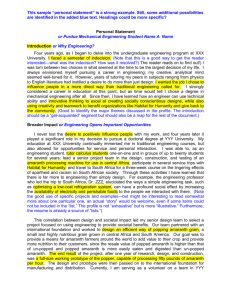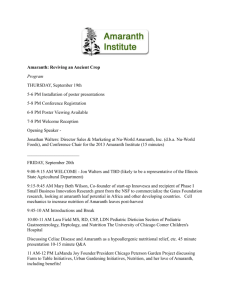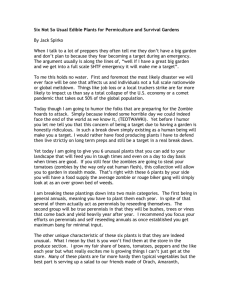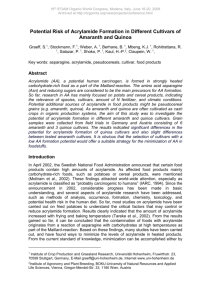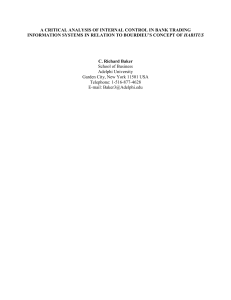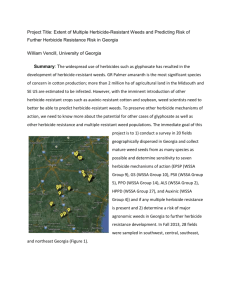Click for link to rest of article
advertisement
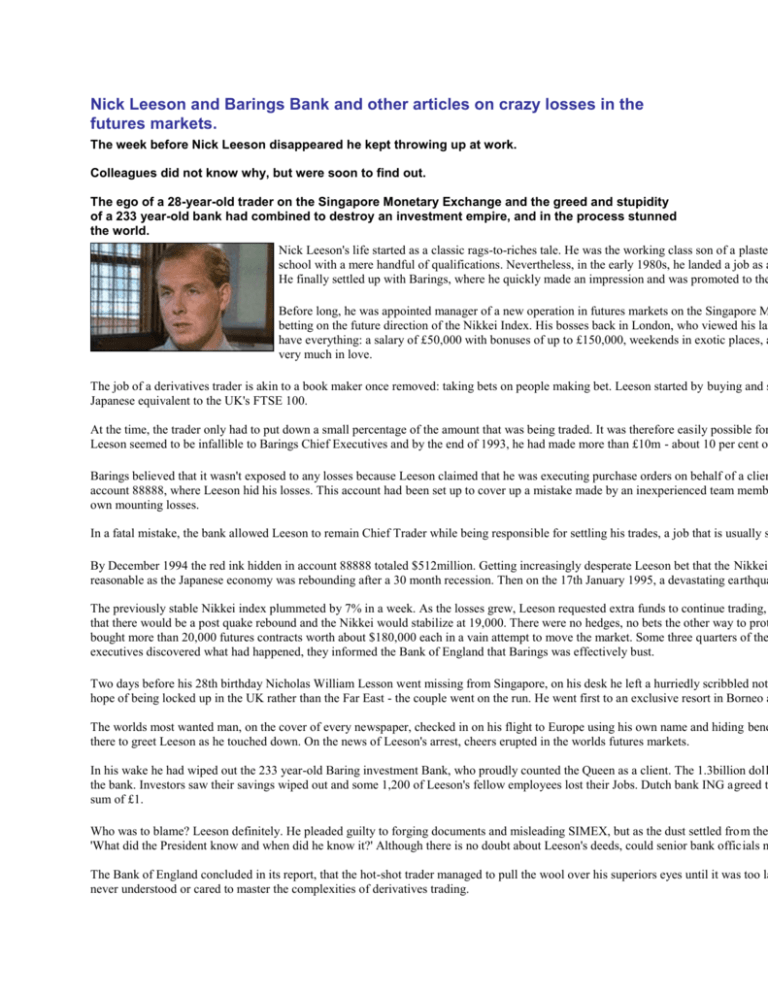
Nick Leeson and Barings Bank and other articles on crazy losses in the futures markets. The week before Nick Leeson disappeared he kept throwing up at work. Colleagues did not know why, but were soon to find out. The ego of a 28-year-old trader on the Singapore Monetary Exchange and the greed and stupidity of a 233 year-old bank had combined to destroy an investment empire, and in the process stunned the world. Nick Leeson's life started as a classic rags-to-riches tale. He was the working class son of a plaste school with a mere handful of qualifications. Nevertheless, in the early 1980s, he landed a job as a He finally settled up with Barings, where he quickly made an impression and was promoted to the Before long, he was appointed manager of a new operation in futures markets on the Singapore M betting on the future direction of the Nikkei Index. His bosses back in London, who viewed his lar have everything: a salary of £50,000 with bonuses of up to £150,000, weekends in exotic places, a very much in love. The job of a derivatives trader is akin to a book maker once removed: taking bets on people making bet. Leeson started by buying and s Japanese equivalent to the UK's FTSE 100. At the time, the trader only had to put down a small percentage of the amount that was being traded. It was therefore easily possible for Leeson seemed to be infallible to Barings Chief Executives and by the end of 1993, he had made more than £10m - about 10 per cent o Barings believed that it wasn't exposed to any losses because Leeson claimed that he was executing purchase orders on behalf of a clien account 88888, where Leeson hid his losses. This account had been set up to cover up a mistake made by an inexperienced team memb own mounting losses. In a fatal mistake, the bank allowed Leeson to remain Chief Trader while being responsible for settling his trades, a job that is usually s By December 1994 the red ink hidden in account 88888 totaled $512million. Getting increasingly desperate Leeson bet that the Nikkei reasonable as the Japanese economy was rebounding after a 30 month recession. Then on the 17th January 1995, a devastating earthqua The previously stable Nikkei index plummeted by 7% in a week. As the losses grew, Leeson requested extra funds to continue trading, that there would be a post quake rebound and the Nikkei would stabilize at 19,000. There were no hedges, no bets the other way to prot bought more than 20,000 futures contracts worth about $180,000 each in a vain attempt to move the market. Some three quarters of the executives discovered what had happened, they informed the Bank of England that Barings was effectively bust. Two days before his 28th birthday Nicholas William Lesson went missing from Singapore, on his desk he left a hurriedly scribbled not hope of being locked up in the UK rather than the Far East - the couple went on the run. He went first to an exclusive resort in Borneo a The worlds most wanted man, on the cover of every newspaper, checked in on his flight to Europe using his own name and hiding bene there to greet Leeson as he touched down. On the news of Leeson's arrest, cheers erupted in the worlds futures markets. In his wake he had wiped out the 233 year-old Baring investment Bank, who proudly counted the Queen as a client. The 1.3billion doll the bank. Investors saw their savings wiped out and some 1,200 of Leeson's fellow employees lost their Jobs. Dutch bank ING agreed t sum of £1. Who was to blame? Leeson definitely. He pleaded guilty to forging documents and misleading SIMEX, but as the dust settled from the 'What did the President know and when did he know it?' Although there is no doubt about Leeson's deeds, could senior bank officials n The Bank of England concluded in its report, that the hot-shot trader managed to pull the wool over his superiors eyes until it was too la never understood or cared to master the complexities of derivatives trading. But Barings could not totally escape blame. An internal memo dated in 1993 had warned the London headquarters about allowing Lees system that will prove disastrous." Nothing was done. In January 1995 SIMEX expressed concern to the bank about Leeson's dealings, report by the Singapore authorities into the collapse regards with disbelief the protestations by Leeson's superiors, all of who were force What became of Leeson? After his arrest in Germany he spent a few fraught months trying to escape extradition to Singapore. He failed years after he pleaded guilty to two counts of deceiving the bank's auditors and of cheating the Singapore exchange. Having served nea to March 2nd, 1995. In jail, he is said to have exercised vigorously, "found God" and spent his days walking up and down, pacing away the time. The fortunes of Leeson's personal life also seemed to mirror the peaks and troughs of his career. As if in a soap story, his wife Lisa got write his book, 'Rogue Trader'. Their marriage at first survived the strain of being apart. But what Lisa could not abide were his revelati another City trader, served to further knock his spirit and he grew very depressed at losing his once devoted wife. Within months, Leeso killed his mother. He had successful surgery whilst in prison. From being a partying, good-time youngster who could abuse his body w He was released early, in the summer of 1999 and his return to the UK brought a realisation that the high life had been swept away; he resilience and has been able to capitalize on his experiences. He made an estimated £50,000 from his book and the fee for newspaper se When the story was turned into a film 'Rogue Trader' starring Ewan McGregor, Leeson was thought to have received a considerable sum conference circuit where he makes considerable sums speaking about his experiences. "I don't think of myself as a criminal" Leeson said before he was tried in Singapore, he has always claimed he made no personal gain fr Losing a $1 billion is bad, how about $5 billion in a week… What went wrong at Amaranth Advisors Wednesday, September 20, 2006 By Ann Davis in Houston and Henny Sender and Gregor Zuckerman In New York, The Wall Street Journal One of the mistakes that led to Amaranth Advisors' multibillion-dollar losses on natural-gas investments is a common one in fast-shifting energy markets: confusing paper trading gains with cash profits. The hedge fund's chief energy trader, 32-year-old Brian Hunter, misgauged when to take his chips off the table, losing roughly $5 billion in a week for a hedge fund that boasted of world-class risk-management systems. While Amaranth had traded energy for several years, its roots were in convertible-bond trading, a different, less-volatile market. According to natural-gas investors who traded alongside Amaranth, Mr. Hunter repeatedly used borrowed money to double-down on his bets. Buying more futures contracts of the kind his fund already owned supported their price by increasing demand, propping up paper gains, these traders say. But that support only lasted as long as Amaranth and its lenders were willing to spend cash to buy more contracts. Such trades may also have masked growing weaknesses in market fundamentals, his trading peers say. As Connecticut Attorney General Richard Blumenthal vowed to investigate the losses, the once-mighty Greenwichbased hedge fund scrambled to explain to investors how risk controls went awry, cutting assets to about $4.5 billion, from $9 billion. Working from Calgary, Alberta, Mr. Hunter employed a routine commodities strategy, exploiting the difference between the prices of contracts for delivery of natural gas at various future points. He also was buying options to buy or sell natural gas at prices that others in the market thought unlikely but that would provide big payoffs if the prices came to pass. Both strategies are supposed to be less risky than simply betting that prices will move either up or down. In an Aug. 29 interview, when Mr. Hunter still had big paper gains, Amaranth Chief Executive Nick Maounis said his bets were meant to minimize risk and maximize reward. "Spreads and options are of their very nature instruments for positions which are designed to allow the user to capture upside with a much clearer understanding with respect to downside exposure," he said. Mr. Maounis was unavailable Tuesday. In a letter to investors Monday, he said the fund so far had met all demands for more cash to back trades and was unwinding natural-gas bets "to preserve investor capital." An Amaranth spokesman declined to comment. Mr. Hunter has not responded to recent interview requests. By early September, as prices fell precipitously because of a storage glut, Mr. Hunter held bets that would pay off exponentially only if natural-gas prices rebounded, either on the prospect of a cold winter or a nasty hurricane that hit natural-gas facilities. But as evidence pointed to a meek hurricane season and mild winter, prices fell more. Amaranth's systems didn't appear to measure correctly how much risk it faced and what steps would limit losses effectively. The risk models employed by hedge funds use historic data, but the natural-gas markets have been more volatile this year than any year since 2001, making models less useful. They also might not predict how much selling of one's stakes to get out of a position can cause prices to fall. "It was a total failure of risk control to put your entire business at risk and not seem to know it," says Marc Freed, a managing director at Lyster Watson & Co., an advisory firm that invests in hedge funds for clients but not with Amaranth. "They were more leveraged than they realized." Commodities trades require less margin money -- collateral to be surrendered in case of losses -- upfront than other markets. On the main exchanges, traders typically post 10 percent of their position's value, whereas in the stock market, 50 percent is common. So say, for example, gas is trading at $7 per million British thermal units and a trader buys one contract to buy or sell 10,000 million-BTUs for $70,000. That trader posts just $7,000 to make that bet. If the price of gas goes down 10 percent, the trader has to post another 10 percent, or $7,000. The trader now has $14,000 tied up in the market, and the value of his position has dropped to $63,000. Compound that with generous lines of credit from banks, and it is easy for commodity hedge funds to get highly leveraged quickly. Funds like Amaranth are able to borrow three to eight times their initial capital to make bets thousands of times over. Mr. Hunter sometimes held 100,000 positions in a single contract, say traders familiar with his bets. The volatile trading that distinguished Mr. Hunter was a departure for Amaranth. Denis Joseph, Amaranth's senior vice president for human resources until 2004, said Mr. Maounis, the CEO, sought to centralize oversight of traders and to keep big discretionary trading authority on the fund's Greenwich trading floor. After big gains in 2005, Mr. Hunter was allowed to trade from Calgary. "To have a relative newcomer ... receive so much discretion is just shocking to me," Mr. Joseph said. Still, the fund's high returns from energy last year and earlier this year were popular with its investors. When Amaranth reported returns of roughly 12 percent in April, it told investors most of that profit was from energy trades. After Amaranth lost about 10 percent in May, or roughly $1 billion, mainly on energy trades, it told some investors that it was cutting back on leverage in the energy market, the investors say. Mr. Hunter's bets ultimately went bad because he misjudged the movement of the difference between prices for different month contracts, known as the spread. People familiar with the trades say he bet prices for nearby-month contracts months would fall and winter contracts would rise. These people say he also presumed gas might be scarce in March if use was heavy this winter and prices would then fall off in April. The fund closed down two weeks after this article with a $6 billion dollar loss in September. An update article from the WSJ is below: HEDGE-FUND HARDBALL Amid Amaranth's Crisis, Other Players Profited Goldman Offered Deal; J.P. Morgan Balked, Then Did One Itself By ANN DAVIS, GREGORY ZUCKERMAN and HENNY SENDER January 30, 2007; Page A1 When Amaranth LLC collapsed in the fall, after swiftly losing more than $6 billion, it was the biggest hedge-fund failure ever. Now as investors slowly get back what's left of their money, it's becoming clear the debacle also had some big winners: other players in the high-stakes energy market who profited from a crippled rival's travails. The final agonies of Amaranth, described by dozens of people close to the roller-coaster negotiations about its fate, began on Friday, Sept. 15. Bleeding cash and facing a Monday demand for money it didn't have, Amaranth scrambled through an intense weekend to find someone who would take over losing energy investments for a price. HEDGE-FUND MILESTONES See a timeline of key events in the history of hedge funds. It did negotiate a rescue plan, requiring it to pay nearly $2 billion to Goldman Sachs Group to take toxic trades off its hands. Strapped for cash, Amaranth aimed to get the money to do the deal by using cash collateral on deposit with its middleman for natural-gas trades, J.P. Morgan Chase & Co. But on Monday morning, just after Amaranth had told its investors a rescue was close, J.P. Morgan said it wouldn't release the collateral. The firm was effectively responsible for making sure parties to Amaranth's trades got paid, and it said the rescue plan didn't free it of this risk, according to people familiar with its stance. J.P. Morgan's refusal killed the plan. Amaranth's situation went from dire to desperate. Two days later, J.P. Morgan itself agreed to take over most Amaranth energy positions. With a partner, it cut a deal that turned out to be lucrative for J.P. Morgan -- earning it an estimated $725 million -- but more painful for its longtime client, Amaranth. Hedge funds are among Wall Street's biggest customers, and the Street gives them red-carpet treatment as the fees roll in. But the Amaranth case shows how Wall Street dealt with a fund after it had traded its way into a deep hole. Information the fund revealed about its holdings as it grasped for a lifeline let other commodity-market players, Wall Street firms included, exploit its positions. As they drove prices relentlessly against Amaranth, its losses swelled, and instead of facing a big but possibly survivable setback, it collapsed. Amaranth's case also reflects an incentive structure in the world of hedge funds that can tempt some to assume heavy risk. Typical of hedge funds -private investment pools for the wealthy and institutions -- Amaranth took 1.5% of investors' assets as a management fee each year, plus 20% of investment gains. This 20% fee is calculated on gains recorded at year end, including gains not nailed down by closed trades. From this take, traders at many firms, such as Amaranth, are given bonuses that are largely theirs to keep, even if the paper gains later shrink or vanish. "This results in a huge incentive for taking risk," says Luis Garicano, a University of Chicago business school professor. "When the bet goes well, the hedge-fund manager collects a lot, while when it goes badly the worst that can happen to the loser is he gets zero." At Amaranth, star energy trader Brian Hunter won an estimated $75 million bonus after his team produced a $1.26 billion profit in 2005. Like many others at the fund, he had to keep about 30% of his pay in the fund. The fund's chief risk officer, Robert Jones, got a bonus of at least $5 million for 2005, say people familiar with the bonuses. Nicholas Maounis -- founder, majority owner and chief executive of the Amaranth management firm -- got an estimated $70 million cut of 2005 management fees, plus some of Amaranth's $200 million-plus in performance fees. He kept much of his compensation in the fund. Asked to comment, a fund spokesman said, "It would be inadvisable for Amaranth to speak on the public record ... at this time. While no litigation has been threatened or commenced against Amaranth, regulatory inquiries continue and litigation remains possible." He said, "Mr. Maounis's No. 1 priority is the continued disposition of the Amaranth portfolio and distribution of capital to investors." WALL STREET JOURNAL VIDEO WSJ's Ann Davis discusses the Amaranth story, noting that the hedge fund's collapse was also a huge opportunity for others on Wall Street. Volatile Market The 32-year-old Mr. Hunter's specialty was natural-gas futures -- contracts for delivery on a future date -- and options. This is a highly volatile market, where the price can move swiftly on changes in gas available in storage and on shifts in the weather -- or a weather forecast. If Mr. Hunter thought prices in, say, March would be higher than what other traders expected, he could buy contracts for March delivery cheaply. If his view of April prices was lower than the market's, he could go the other way. Or he could bet on the spread between a pair of months. For example, if there's a cold winter, gas can suddenly get scarce in March, sending prices skyrocketing. Things shift in April, as the heating season winds down. The March-April spread is one many gas traders bet on, but can be such a perilous bet that some call it "the widowmaker." Mr. Hunter bet big. He sometimes held 30% of contracts for gas delivery in certain months, say people who saw the trading data. His team, operating largely out of Calgary, Alberta, made a stunning $1.5 billion in six weeks last spring, mostly on energy trades. But gains that big in a single market can portend swings just as fast the other way, and in May that's what happened. His bets on gas prices years into the future backfired and dealt the fund a sudden loss of about 10%. That triggered demands for more collateral from J.P. Morgan. It was Amaranth's natural-gas clearing broker, a firm that executes a client's trades on an exchange and stands behind the client's obligations in case it can't pay. Clearing brokers give futures traders confidence they'll be paid if they are owed money when a contract expires. For taking this risk, the firms demand collateral, known as "margin," in an amount of cash reflecting a portfolio's possible one-day price move. The margin demand fluctuates daily with how well or badly the positions did that day. Amaranth told its investors the May loss was "a humbling experience that has led us to recalibrate how we assess risk." To reduce its exposure, it paid investment bank Morgan Stanley to take over part of its energy portfolio. Yet officials at the New York Mercantile Exchange, where many energy contracts trade, were concerned enough that they discussed what a failure by a player as big as Amaranth might do to the market. The regulators took comfort in the stability of J.P. Morgan. The bank at times advised Amaranth to reduce its natural-gas exposure, says someone familiar with the bank's operations. But the clearing operation focused chiefly on whether the fund met margin requirements, as Amaranth always did. According to a person involved in the discussions, Amaranth's Mr. Maounis told his energy team to reduce its exposure, but warned them not to do so precipitously, lest the firm suffer another major loss. Amaranth's positions were so big they couldn't be unwound fast without moving the market. But Amaranth allowed the portion of the fund invested in energy to grow, as the energy bets started to pay off again. By July, Amaranth was 56% in energy, up from 34% in April. In the last week of August, the value of the fund's assets reached $9.2 billion, up about 27% since Jan. 1. One of Mr. Hunter's bets anticipated relatively cheap gas in September. But in the last half hour of trading Aug. 29, the price of the expiring contract for September delivery jumped. The surge wiped out hundreds of millions of dollars in Amaranth's gains. The fund told Nymex it suspected someone had manipulated prices. Regulators are looking at it. Then in early September, widely watched weather-forecasting centers made two predictions: that the hurricane season would pass without major storms, and that the winter would be mild. The forecasts, too, slammed Mr. Hunter. He was betting on a gas shortage and price spike at some point after October. Worse, contracts for winter delivery fell by more than those for early-fall delivery, hitting him where his bets were concentrated. By the end of Friday, Sept. 15, Amaranth was down more than $2 billion from its August value. Margin Calls The losses automatically raised J.P. Morgan's margin demands. One of the ways Amaranth had met past demands was selling nonenergy investments to raise cash. But now it turned out some couldn't be liquidated instantly, say people involved. Amaranth suddenly faced a risk of not having enough cash for Monday's margin demand. If it didn't, creditors could foreclose on its assets and it might lose them. Amaranth called Wall Street banks in search of solutions. It asked Goldman Sachs if the bank, a major player in both energy markets and hedge funds, would take over much of Amaranth's energy portfolio. The fund tried a different tack with others, trying to raise money by selling a piece of the fund-management firm, Amaranth Advisors LLC. Firms prefer to do negotiations like these secretly and one at a time, to avoid revealing too much to too many rivals or signaling vulnerability. But Amaranth's Greenwich, Conn., office that weekend was a revolving door. Morgan Stanley representatives spotted someone from Merrill Lynch & Co. in the parking lot. Rumors flew. On Saturday, Goldman offered to do a deal designed to eliminate most of Amaranth's energy risk -- in return for a $1.7 billion cash payment from the fund -- say people familiar with the negotiations. Amaranth managers were insulted. Mr. Hunter had figured the fund could get out of these problematic trades for about $800 million. Amaranth kept shopping. It called John Arnold of Centaurus Energy, a Houston hedge fund that was Mr. Hunter's biggest rival. No deal. With others they talked to, some Amaranth traders claimed Mr. Arnold was driving gas prices against Amaranth, according to someone who was approached. Their pitch was: We've got one guy in the market trading against us. If you take over our positions and hold onto them, you can make a billion dollars. A Deal With Merrill Later that Saturday, Amaranth managed to make a partial deal. It got Merrill Lynch to assume about a quarter of its natural-gas exposure, in return for a payment of approximately $250 million, say people familiar with the matter. Merrill won't comment. Amaranth officials figured that Goldman Sachs now would reduce its price, since Merrill was taking some of the exposure. Instead, Goldman executives fumed, say people familiar with their reaction; Goldman had wanted to negotiate exclusively, not have competitors poring over Amaranth's books. Rather than reduce its price, Goldman upped it, to $1.85 billion. The deal it envisioned would use derivative contracts to assume most of the risk of Amaranth's main remaining energy investments. Goldman would do trades that partially offset energy trades on Amaranth's books, with the aim of neutralizing them. The deal would leave a lot of positions on Amaranth's accounts at J.P. Morgan, which remained responsible for their execution. Some at J.P. Morgan, including Chief Executive James Dimon, had grown concerned about Amaranth. Late Sunday, J.P. Morgan called in its top energy trader, George "Beau" Taylor, to review Amaranth's positions. Informed that an Amaranth-Goldman deal was imminent, J.P. Morgan said it might make an offer itself, but then said it needed more time. In Greenwich, Mr. Maounis was in turmoil, sometimes losing composure and in tears, according to people familiar with the matter. Late that night, he accepted the deal with Goldman. On Monday morning, the sleep-deprived fund chief issued a letter to investors, telling them that half of the money the fund had at its peak 2½ weeks earlier was gone. Instead of being up 27% for the year, it might be down more than 35%. But his letter gave an assurance. It said a deal to get the fund out of natural gas was "near completion." The letter didn't mention that a key player still needed to sign off: J.P. Morgan. The clearing broker held an estimated $1 billion to $2 billion of Amaranth's money in a margin account, cash that Amaranth intended to use to pay Goldman. Amaranth held a conference call intended to close the Goldman deal. But as officials from Goldman and Nymex listened, J.P. Morgan refused to release Amaranth's collateral -- scotching the deal. The bank said it believed the complex transaction wouldn't eliminate its risk. J.P. Morgan would still be the clearing broker for Amaranth's energy positions. And although Goldman and Amaranth claimed that the risk in those positions would be drastically reduced by Goldman's offsetting trades, J.P. Morgan would be the clearing broker for those new trades, too. The firm said it needed to analyze how the deal worked. It also argued that it had a right, and perhaps a duty, to hold onto the margin money until its obligations were resolved. "We would have been absolutely willing to facilitate a deal that would have removed unwanted Amaranth credit exposure from our risk profile," a J.P. Morgan spokesman said. In the energy market, it was now open season on Amaranth. All weekend, others had been dumping natural-gas positions on after-hours trading platforms, having either heard rumors about Amaranth or been invited to review its books. On Monday, with word of the fund's distress out in the open, traders sold certain gas investments even faster, in anticipation of a forced liquidation of Amaranth's portfolio. For instance, Mr. Hunter had bet that the spread between March-delivery gas contracts and April contracts -- the "widowmaker" bet -- would widen. The burst of trading made it shrink, to 75 cents per million-BTU gas contract from $1.15 on Friday, according to NaturalGasAnalytics.net. On Monday alone, Amaranth's losses deepened by several hundred million dollars. That morning, Amaranth got a call from Kenneth Griffin, founder of Citadel Investment Group. Mr. Griffin had built Citadel into a $13 billion hedge-fund behemoth estimated to be responsible for 3% of daily trading on the New York Stock Exchange. Even so, his group suffered some losses during Mr. Hunter's 2005 winning streak. Mr. Griffin proposed taking over most of Amaranth's energy portfolio. That portfolio now was in worse shape because of Monday's losses. The more it deteriorated, the more cash an outsider would demand to take it off Amaranth's hands. The Citadel deal would have cost Amaranth more than $2 billion, say people familiar with the bid. And the fund couldn't pay, with its collateral hung up at J.P. Morgan. Mr. Griffin considered giving the hedge fund time to pay by granting it a bridge loan, taking other Amaranth assets as collateral. He dropped the idea when lawyers warned that Citadel might have a hard time collecting if Amaranth ended up in bankruptcy. With the Citadel plan shaky, J.P. Morgan got back in the game. In conjunction with Citadel, J.P. Morgan, which itself is a big hedge-fund player, began new talks with its now-very-vulnerable clearing client. The end result was a broader deal than the scuttled Goldman one: J.P. Morgan and Citadel would jointly assume Amaranth's entire remaining energy portfolio. Amaranth would have to eat losses of about $800 million its portfolio had incurred from Friday night through Tuesday as others exploited its weakness. J.P. Morgan and Citadel wanted $1.6 billion to take over most remaining gas trading positions and some $300 million to assume options to buy or sell gas. As a topper, they asked for $250 million for taking over miscellaneous commodity investments. Mr. Hunter thought the price for taking over the miscellaneous positions should be no more than $50 million, says someone involved in the talks. Amaranth capitulated. After an all-night session, the deal was signed at 5:30 a.m. Wednesday. Amaranth's total payments to Merrill Lynch, J.P. Morgan and Citadel, plus the last few days' market losses, came to about $3.2 billion. Now that J.P. Morgan was in on the deal, getting access to the Amaranth cash that J.P. Morgan held as collateral was no longer a problem. His business in tatters, Amaranth's Mr. Maounis, 43, discussed selling what was left of his fund-management firm to Citigroup Inc. Dean Barr, an official of Citigroup's Alternative Investments group, was interested but wouldn't buy unless Mr. Maounis stepped down as the firm's chief, says someone familiar with the talks. Ultimately, negotiations foundered over other issues. So Amaranth began liquidating its remaining holdings. Mr. Hunter flew back to Calgary and settled into a new house he had been building. He is now talking about launching a hedge fund of his own. Mr. Maounis also is exploring starting a new hedge-fund business. 'Very Nice Increment' The three firms that were paid hundreds of millions of dollars to take over Amaranth trades -- Merrill Lynch, Citadel and J.P. Morgan -- soon reported significant profits on energy trading. J.P. Morgan made at least $725 million, partly by quickly selling many of its new positions to Citadel. The Amaranth deal produced a "very nice increment to fixed-income trading," Mr. Dimon, J.P. Morgan's CEO, said in a speech in November. "But we did take a lot of risk." Bill Winters, co-head of J.P. Morgan's investment bank, said at a November conference that through its hedge-fund relationships, such as trade clearing, "we have the insight into what's going on in these funds" and can "respond quickly to opportunities when they come up. Amaranth was one obvious example of that." He added, "I imagine there will be others...where our ability to be both on the inside, but not compromised, is extremely powerful [as a way] to generate profits." The huge, complex deal with Amaranth helped build J.P. Morgan's profile as a commodities player. This month, a magazine called Risk named the firm "Energy Derivatives House of the Year." How much the investors in Amaranth will lose depends on when they got in. They've gotten back about $1.6 billion to date. For one investor that came in in mid-2005, money returned so far comes to 27% of what it put in and about 18% of what its stake was worth at the peak. Investors will receive somewhat more when Amaranth finishes liquidating. Some investors have a keepsake. Amaranth once sent chess sets as year-end gifts, inscribed with a quotation from the late grandmaster Alexander Kotov: "It often happens that a player carries out a deep and complicated calculation, but fails to spot something elementary right at the first move." --Robin Sidel contributed to this article More Recently, Jerome Kerviel has topped them all. Lost over $7 billion and he supposedly was only allowed to have market exposure of less than $1 million. How to Lose $7.2 Billion: A Trader's Tale Kerviel Cooked Books, Skipped His Holidays; Calling in a Doctor By DAVID GAUTHIER-VILLARS and CARRICK MOLLENKAMP February 2, 2008; Page A1 PARIS -- In the early afternoon of Saturday, Jan. 19, Jérôme Kerviel was on a weekend break by the sea when he got a call on his mobile phone from his boss at Société Générale. "We need some explanations," said a manager of Delta One, a lowly trading unit that handled humdrum, low-risk trades, according to people familiar with the conversation. Mr. Kerviel, who was in Deauville, a fashionable seaside resort famed for its horse races and palatial casino, was told to get back to the office in Paris. He caught a train for a threehour journey to Société Générale's headquarters. Today, two weeks after Mr. Kerviel's beach break was cut short, a picture is starting to come together of the junior trader who, undetected, caused the largest single trading hit in banking history. Previously unreleased details of the transaction that first brought him down, along with interviews with bank executives, prosecutors and Mr. Kerviel's own lawyers, reveal a man who knew the risks but thought he could beat them -- and whose undoing has exposed the frictions within one of France's proudest and most elite banks. Calling in a Doctor Mr. Kerviel arrived at the bank around 7 p.m. on the night of Jan. 19. He was marched into the offices of Jean-Pierre Mustier, a former paratrooper and academic whiz with a buzz-cut who heads Société Générale's investment-banking division. At the beginning, Mr. Kerviel was questioned about a single trade that had been discovered the evening before and aroused concern: a transaction with a German brokerage house that had seemingly lost the bank €1.5 billion ($2.22 billion). He gave little away at first. "He's a very silent man," said a senior official. "It was a lengthy process." As the meeting dragged on into the night, Mr. Kerviel eventually admitted that the German trade was fake, according to bank officials. Worse, it was just one of numerous fictitious transactions booked by Mr. Kerviel to mask a mass of real and highly risky deals. Mr. Mustier and fellow executives grilled Mr. Kerviel until three in the morning. Stress levels rose to the point that, fearful Mr. Kerviel might crack under the strain, they called in a doctor. After monitoring the trader's condition, the doctor said he could go home for a few hours sleep and then return in the morning, according to people familiar with the meeting. By Sunday, Société Générale was forced to confront a shocking truth: Mr. Kerviel -- a junior trader paid a modest annual base salary of around $70,000 -- had gambled more than the bank's entire worth in high-risk bets. Some €50 billion was on the table -- and the roulette wheel was about to start spinning again with the opening of markets on Monday morning. Mr. Mustier entrusted one of his best traders with the task of unwinding the bets. The result, by the time the information was released to the public on Jan. 24, was a loss of $7.2 billion -- the largest single trading hit in banking history. The disclosure shook world markets and has led French bank BNP Paribas SA to begin considering a bid for Société Générale. The bid could include French bank Credit Agricole SA. Numerous accounts from those involved, including Mr. Kerviel's own testimony, suggest that at the root of the debacle was an unstable mix of forces: the frustrated ambitions of a striving provincial and the hubris of his managers. Each tended to disdain the other. Mr. Kerviel admits to openly flouting the rules imposed by his superiors. Bank executives, meanwhile, say they missed a series of warnings, both internal and from outside, about the risks Mr. Kerviel was taking. The trader, in his testimony to investigators, scoffs at the bank for missing an elementary sign that something was wrong: he only took four days of holiday last year. "It is one of the first rules of internal controls: a trader who doesn't take holidays is a trader who doesn't want his books to be seen by others," he said. Runaway Ambitions Mr. Kerviel, the son of a hairdresser and metal worker raised in a small town in Brittany, occupied one of the lowest perches in derivatives trading at the bank. But he yearned to prove that he could match and even exceed better educated and more highly valued colleagues. At one point last year, said a lawyer involved in the case, Mr. Kerviel asked for a bonus of between €600,000 and €1 million -- far beyond what a trader at his level would normally receive. Mr. Kerviel was well aware of his lot at the bank. "But this did not dampen my ambitions," he said during questioning by police last weekend, according to a partial transcript. While Mr. Kerviel burned with a sense of his own worth, Société Générale paid little attention to him or other nutsand-bolts traders on Delta One and focused instead on nurturing so-called "quants," traders with advanced academic degrees who used complex mathematical models to make money for the bank. For many years, this approach paid off. Société Générale earned a reputation as a world-class center of sophisticated derivative trading. Its prestige seeped into popular culture: In the 1999 movie "Rogue Trader," a film chronicling the collapse of Barings Bank, Société Générale is mentioned as the rising trading power. The quants, many of them Ph.D.s in mathematics or astrophysics, mostly came from elite French colleges, as did Mr. Mustier, the head of investment banking and a graduate of two of France's most selective engineering schools. Mr. Kerviel, in contrast, went to second-tier colleges in Nantes and Lyon, where he studied to become a back-office controller. Even when confronted with the first evidence of the audacity and scale of Mr. Kerviel's misdeeds, "we didn't think it was possible," said a senior Société Générale executive. "I kept thinking: Who is this guy?" Société Générale, a bank that traces its roots to Napoleon III in 1864, has staked its modern future in part on its mastery of its highly-complex, mathematics-driven equity-derivatives trading business. It is a big money-spinner and powerful marketing tool for the bank. In the fall of 2005, Mr. Mustier and a lieutenant gave a presentation of the business at the bank's mirrored-glass, multitower headquarters in Paris. The title of the pitch: "Well-armed to outperform the industry." 'Bingo, 500,000 Euros' At the same presentation, executives played up the computer systems and staff the bank used to ward off risk. The bank's equity-derivatives unit hadn't had any "major incident" in 15 years, they said. Only a few months earlier, Mr. Kerviel had joined this very division of the bank. His unit, Delta One, was the lowest rung on the ladder. Trading required little of the mathematical sophistication used by Société Générale's big-time derivatives traders, the "quants." Mr. Kerviel had dual tasks. The first was selling packaged investment products with lofty names such as "Everest" or "Kilimanjaro." His other job consisted of betting on whether European stock markets would rise or fall. The roughly 20 traders on the Delta One desk were supposed to offset each bet that a stock index would rise with another bet in the opposite direction in order to keep risk at minimum levels. The difference between the parallel bets would generate either a profit or a loss. Even though he was low in the pecking order, Mr. Kerviel believed he had the talent to excel and was determined to prove it. "He thought he had a special flair, a capacity to sniff out market trends," said Jean-Claude Marin, the Paris prosecutor involved in the case. Within months of joining Delta One, Mr. Kerviel began putting his chips all in one direction, rather than hedging bets as he was supposed to do. For example, in the summer of 2005, he bet on a market tumble. Soon after, a group of Islamic suicide bombers attacked the London transport system. This sent European markets into a dive and Mr. Kerviel's fortunes soared. "Bingo, 500,000 euros," Mr. Kerviel said, recalling the episode during his testimony to investigators. He said he was "both proud and surprised by the results," and this made him want to continue. "There's a snowball effect." Mr. Kerviel's jubilation fed what Mr. Marin, the prosecutor, last week described as "an addiction." For the next 18 months, Mr. Kerviel kept breaking the rules, but within modest margins, according to both the trader's testimony and Société Générale officials. He knew how to avoid detection, having started his career at the bank in 2000 in the back-office, or so-called "mine," where hundreds of clerks process and monitor transactions of their better-paid trading colleagues. Early Missteps By January 2007, Mr. Kerviel was making bolder bets -- and getting away with it even when he lost money. He wagered, for example, that the German share index DAX would fall. Instead, the index increased from 6596.92 to 6789.11 that month, leaving him in the hole. But, he told prosecutors, the loss went unnoticed by his managers because during that period of the year "there is no cross-checking control within SocGen." Jean Veil, a lawyer for Société Générale, says the bank had rigorous controls throughout. Bank officials say they couldn't detect Mr. Kerviel's gains or losses because he masked them with fake trades, creating the illusion that all his positions were hedged. By February 2007, the markets dipped slightly, and Mr. Kerviel was able to trade his way from a large loss to a gain of €28 million. He told prosecutors that he was "proud and satisfied" by this change of fortune. By early spring 2007, however, the subprime-mortgage market in the U.S. put Mr. Kerviel and many other investors and traders around the world on a roller-coaster. In his testimony, Mr. Kerviel says that he began to read up on the subprime woes in the U.S. He noticed that many experts believed the subprime problems wouldn't halt the markets' upward trend. He decided to bet that it would. Initially, he was wrong. Between March and July, the market rose, exposing him to a large potential loss. Société Générale said that at one point during this period Mr. Kerviel had an unhedged exposure worth €30 billion, with a net loss of €2.2 billion. In early April 2007, according to Mr. Kerviel's testimony, a Delta One manager received an email from Société Générale's back office warning of a problem and confronted him about it. "I was told to sort it out," Mr. Kerviel said. Société Générale says that on such occasions Mr. Kervial would often produce fake emails to calm concerns. But by July, the market dropped, reversing Mr. Kerviel's losses. Suddenly Mr. Kerviel found himself with a €500 million gain. This created another problem: how to tell his bosses. He had outsmarted the market but couldn't boast about it because it would reveal that he had been wagering way beyond what he was supposed to and hiding the bets with fake trades. "I found myself very intimidated by these 500 million euros and, above all, by not knowing how I would let people know about it," Mr. Kerviel said. Mr. Kerviel claims that the bank's security systems often sounded the alarm, but he would easily deflect inquiries. But at a modern glass building on the western outskirts of Frankfurt, Mr. Kerviel's trades were getting noticed. A Close Call On Nov. 7, the Trading Surveillance Office at Eurex, the derivatives exchange run by German exchange group Deutsche Börse, sent an email to Société Générale to find out why Mr. Kerviel was sending a massive volume of trades through the German futures exchange, Société Générale officials said. The bank's back office forwarded the email from Eurex to Mr. Kerviel, who skirted the request for details by saying he didn't want to reveal his trading strategies to competitors, according to Société Générale's lawyer. Eurex sent a second email, saying it needed a better explanation. In the end, Mr. Kerviel managed to provide a response that convinced his bank and Eurex that there was nothing untoward. By the end of December, Mr. Kerviel's books had a gain of €1.4 billion -- all of which was hidden from the view of his supervisors. By now, keeping all his trades hidden required constant juggling and vigilance. He needed to regularly delete and reenter his fake trades in order to avoid being detected. Mr. Kerviel continued skipping holidays. In one instance, he told managers that he was in no mood to take time off because it would remind him of his recently deceased father, according to Société Générale officials. In January of this year, as markets churned, Mr. Kerviel was scrambling to conceal the €1.4 billion gain in his book. On Jan. 3, the trader confected a series of fictitious transactions to mask the gain. He booked a trade in the name of a German brokerage house. The move triggered an alarm bell within Société Générale's systems, requiring the bank's back office to check the credit worthiness of the brokerage. Caught When asked for details, Mr. Kerviel tried a last gambit: He said he had made a mistake naming the brokerage and that actually the transaction was with a more respected bank, Deutsche Bank, according to a Société Générale lawyer. The back office began a series of checks. Mr. Kerviel kept trading. By the evening of Friday, Jan. 18, previous gains had evaporated. Mr. Kerviel was sitting on a hole of around €1.5 billion. Having weathered previous close calls, Mr. Kerviel figured he could fix the problem at the start of trading the following Monday, according to his testimony. He went to the beach in Deauville. But that night, the risk-management system he had fooled so many times picked up on his position. Checks revealed that Deutsche Bank hadn't recently traded with Mr. Kerviel. Mr. Mustier, the head of investment banking, got a call late Friday to tell him this. The following morning, Mr. Mustier and other executives gathered to dig into Mr. Kerviel's books. The trader got a call on his mobile phone summoning him back to Paris from the seaside. Grilled late into the night at Société Générale's headquarters, Mr. Kerviel acknowledged that the trade with Deutsche Bank never existed and then revealed far more disturbing news: his books contained genuine trades that exposed the bank to a €50 billion risk. A fire warden on duty on Saturday night recalls seeing Mr. Kerviel leave. "He was not looking so good," the guard said. A week later, Mr. Kerviel turned himself into police. After two days of questioning, investigators asked Mr. Kerviel: "Are you a gambler? "No," the trader replied. "I shoot pool." In a French Twist, Infamous Trader Gets Hero Treatment Bank Finds It Hard to Say Au Revoir to Mr. Kerviel; 'Che Guevara of Finance' By ANDREW HIGGINS February 1, 2008; Page A1 PARIS -- Société Générale says wayward trader Jérôme Kerviel lost the bank $7.2 billion. But that was last week. He's now on his way to cult celebrity -- and he still hasn't lost his job. Société Générale has stopped paying Mr. Kerviel and told him not to come to the office, but it hasn't managed to formally fire him. French law stipulates that to do that, the bank must first call him in for a sit-down meeting and explain its dissatisfaction. He has the right to bring along a trade-union official, a lawyer or anyone else he'd like. That will be complicated: A pair of Paris judges this week released Mr. Kerviel from custody but forbade him to have contact with the bank. "This is a very peculiar case," says Emmanuel Dockès, a law professor at l'Université Lyon 2, Mr. Kerviel's alma mater in central France.
